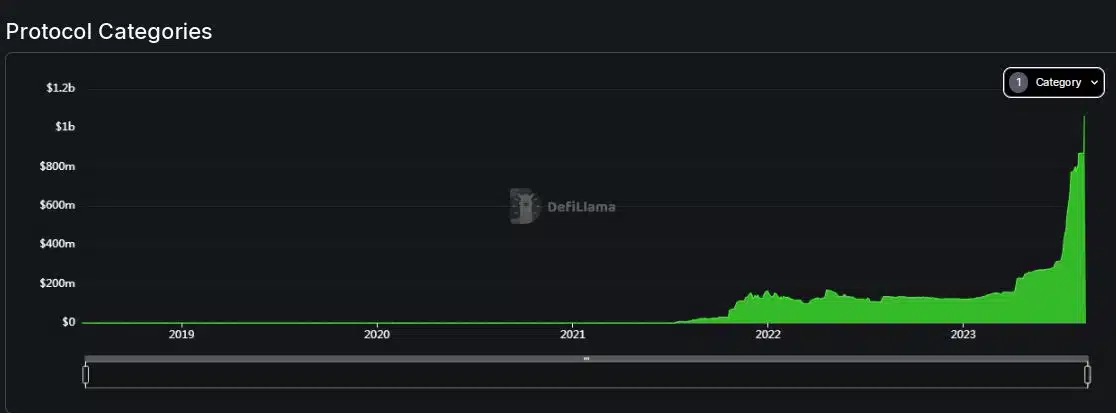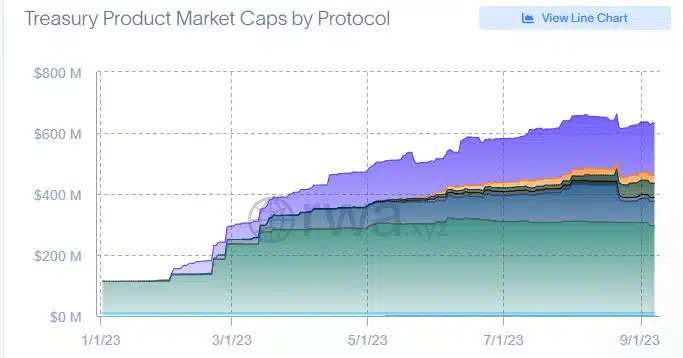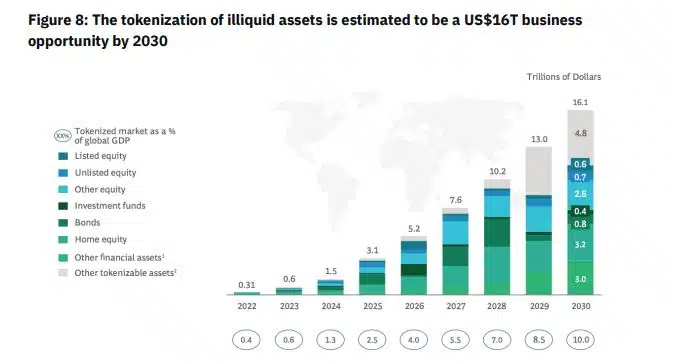Real-world assets take blockchain world by storm – The next big thing?

- From a TVL of just $316 million at the end of Q2, the sector has more than quadrupled.
- The total value of all tokenized treasury product tokens was $632 million at the time of writing.
Real-world assets, or more popularly known in blockchain parlance as RWAs, have emerged as one of the hottest trends in the sector at the time of writing. This unique blend of TradFi with digital assets offers enormous potential and a plethora of opportunities that the two industries can capitalize on in the near future.
What’s the fuss about RWA?
As the name suggests, RWAs exist in the physical world and form a significant composition of the TradFi market. Examples of these include real estate, commodities, bonds, artwork, currencies, and much more.
Through tokenization, these off-chain assets are brought onto the blockchain, thereby creating a new investment opportunity for decentralized finance (DeFi) enthusiasts. Now the next question that could cross your mind is why the need of tokenization in the first place?
Well, tokenization of RWAs brings the same set of advantages that any decentralized setup attempts to give. Notable among these are the elimination of intermediaries, the ability to trade things 24 hours a day, seven days a week, as opposed to “working hours” in TradFi, and improved transparency and trust.
Moreover, the investment yield in RWAs could be less affected by the notorious volatility of crypto assets. Therefore, it’s hardly a surprise that many TradFi giants are showing increased interest in leveraging these novel assets.
Current state of the market
Binance recently published a blog, delving into the present state of the market and trends developing in the niche ecosystem.
According to DeFiLlama, RWAs were the eighth-largest DeFi sub-sector at the time of publication, with a total value locked (TVL) of $1.46 billion. For context, this was more than the liquidity locked on decentralized derivatives exchanges.
As evident from the above graph, RWAs exploded in the third quarter of 2023. From a TVL of just $316 million at the end of Q2, the sector has more than quadrupled as of press time. On a year-to-date (YTD) basis, this equated to a colossal 1100% growth, an astonishing feat for a market which, arguably, was still in its early stages of development.
The increased adoption was also reflected in the steady rise of token holders. As per Dune, about 43,518 RWA token holders were present on the Ethereum [ETH] chain as of this writing, representing a 75% growth from a year ago.
U.S. Treasuries on blockchain?
One of the biggest success stories of the RWA sector has been the tokenized treasury market. As is well known, U.S. Treasuries, or the debt issued by the U.S. government, has remained one of the safest and most reliable refuge against uncertainties in the TradFi market.
Moreover, yields on these investments have been steadily rising recently, over investor bets that the U.S. Federal Reserve would continue to hike interest rates. Higher yields on bonds generally cast a negative effect on riskier assets like stocks and DeFi because it’s natural for capital to shift to instruments which provide better returns.
However, with tokenization of treasuries, DeFi investors can enjoy real-world yields through blockchain technology.
According to rwa.xyz, the total value of all tokenized treasury product tokens was $632 million at the time of writing. Moreover, the average yield on the bonds was an attractive 5.25%.
Ondo Finance and Franklin Templeton emerged as the largest RWA protocols providing liquid exposure to short-term U.S. securities.
The majority of these projects were built on Ethereum, which had the largest treasury market cap at roughly $315 million. However, Stellar [XLM] was also a force to be reckoned with as it was home to Franklin Templeton’s protocol.
Maker’s strategic push into RWAs
Of late, decentralized central bank MakerDAO [MKR] has tried to give real-world assets (RWAs) a bigger role in its stablecoin DAI’s collateral reserves. It diverted a part of its revenue earned through U.S. Treasury bonds to offer high yield to holders of the stablecoin. This resulted in a sharp increase in DAI’s circulating supply.
The long-term potential of RWAs looked promising. Binance stated that the tokenized assets market is expected to grow to $16 trillion by 2030.










